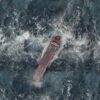Executive Order on Imposing Sanctions with Respect to Additional Sectors of Iran

Executive Order on Imposing Sanctions with Respect to Additional Sectors of Iran The White House…
Gemini Shippers GroupJanuary 12, 2020


